Top News
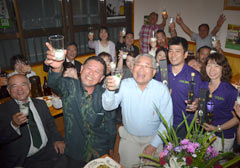
April 17, 2014 Ryukyu Shimpo
A new bar serving the Peruvian liquor pisco has opened in the Adaniya district of Kitanakagusuku. Sixty-six-year-old Miguel Gusukuma, a second generation Okinawan Peruvian from Kitanakagusuku, is the only person of Okinawan descent in Peru who produces pisco, which he will serve at the new bar called Colibiri. On the night of April 15, a celebratory gathering was held to give locals and industry members a chance to taste the Gusukuma’s locally brewed pisco. People involved in the import business remarked on the liquor’s aroma and clear taste.
An owner of the bar, Toshishige Shiroma is Miguel’s nephew. He said he was proud of his uncle’s achievement. “I think my uncle has faced several hardships since his father’s generation moved to Peru. It is not easy to achieve success,” Shiroma said.
Pisco is a liquor made from grapes and one of the most popular Peruvian liquors. Toasting with pisco sours is a common feature of Peruvian celebrations. Pisco Gusukuma is characterized by its rich fragrance of white grapes.
Tomohiro Nakata,president of Gifu prefecture-based Giarlinks, and an importer of Pisco Gusukuma, joined the gathering. The company imports 5,000 bottles of pisco, supporting farmers of Japanese descent in South America. Nakata said,”I would like to start promoting pisco from Miguel’s hometown Kitanakagusuku. I hope to uphold this cultural exchange that began with pisco.”
Colibri sells Pisco Gusukuma. It has an abv of 42 percent. The liquor sells at 2,800 yen a bottle. For further details, call at 098 (935) 0128.
(English translation by T&CT and Lima Tokumori)
Go to Japanese
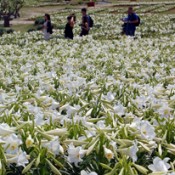
April 20, 2014 Yukito Kinjo, correspondent of Ryukyu Shimpo
The 19th Lily Festival started at Lily Field Park in Ie Village on April 19.
The flower will be in full bloom by the end of the month when Golden Week holidays start. About 100 flowers will form a white carpet to fill the park. With admission free, the event will last until May 6.
Since the festival began, many families and tourists have visited the park and enjoyed smelling the blossoms. The Village Mayor Hideyuki Shimabukuro said, “I would like many tourists to enjoy the event this year.” For the opening of the event, kindergarten pupils danced eisa and members of the Village Women’s Association performed a ryukyuan traditional dance called Yotsudake.
A shuttle bus is running from Ie Port to the park. For further details, call the executive committee of the festival at 098 (049) 2906.
For further details on the ferry, call the Village Office at 098 (049) 2255.
(English translation by T&CT)
Go to Japanese
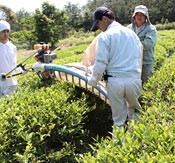
April 17, 2014 Ryukyu Shimpo
On April 15, tea production company Kanegawa Tea Factory began harvesting Benifuki black tea at the tea farm in Sate district of Kunigami Village. Takayoshi Ota of the Kunigami Village Office who inspected the harvesting site, said, “I hope the tea will become popular in the international market and attract new farmers to the village.” Oku district of Kunigami is mostly known for green tea fields. Eight years ago, the company started a black tea farm in Sate. Last year, it harvested a low amount of the tea leaves for the first time. The company began large-scale harvesting at the start of this year.
With the tea farm of about 5,000 square meters, the company plans to produce 50 kilograms of the tea leaves this time. It expects to increase the production volume in the future.
Okinawa is located at the same degree of latitude as Assam in India, which is a major region for black tea production. The prefecture’s acid red soil is also suitable for the tea production. Takeshi Higa, the representative of the company, and his son Ryuichi harvested the tea leaves. Ryuichi said, “The tea trees are young and the amount of crop is still low. However, I hope that our tea will become popular among black tea lovers.”
(English translation by T&CT and Megumi Chibana)
Go to Japanese
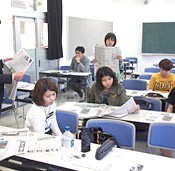
April 16, 2014 Ryukyu Shimpo
On April 15, at the University of the Ryukyus in Nishihara, the Ryukyu Shimpo newspaper and the university’s Faculty of Education cooperated to launch a newspaper course. The course is a continuation from the last academic year. It aims to teach students the role and structure of newspapers, and how they can be used in education, by introducing examples of NIE (Newspapers in Education) to students who hope to become teachers.
Nine students in the faculty of education are enrolled in the course. They will be coached in how to use newspapers as reliable and accessible information sources. For instance, they will learn how to interpret the newspaper writing style and structure, such as brief headlines and text.
Tsuyoshi Matsumoto, the head of the news department’s headquarters and department for promoting NIE, will deliver the course in the first semester.
Matsumoto introduced the results of the survey carried out by the Organization for Economic Co-operation and Development (OECD) on newspapers. The survey results showed that students who read newspapers, have a higher reading ability than those who don’t. He claimed that it is important for teachers to make students media literate by getting them to collect and interpret information from newspapers.
Working in groups, students discussed articles that they were interested in.
A junior student Sakura Kina said she hoped to learn ways to express her opinions effectively in the newspaper style, and read critically. “It is useful to know the structure of newspapers and understand what articles can say with limited space, and not accept information without questioning.”
(English translation by T&CT)
Go to Japanese

April 17, 2014 Ryukyu Shimpo
Seventy-five-year-old sculptor Minoru Kinjo, based in Yomitan Village, will present a pair of large-sized shisa to the Okinawa Association of Argentina. Shisa is a traditional Okinawan ceramic art. Shisa or lion-dogs are believed to ward off evil spirits. The sculptures will be sent by ship to Argentina. The association will erect them at the main gate of its athletic field in Buenos Aires in the middle of June.
On April 11, Kijo and supporters for the project held a completion ceremony at his atelier in Gima district of the village and prayed for safe shipping to the South American country.
The sculpture is 215 centimeters high and one meter wide. Its overall length is two meters. Using cement plaster and cement, Kinjo took three months to complete the shisa.
Seeing Kijo’s creative activities on a TV program, the people involved in the association asked him to create shisa sculptures.
Kinjo decided to do it for free because his relatives live in Argentina.
About 80 people, including friends of Kinjo and the Village Mayor Denzitsu Ishimine took part in the ceremony.
Kinjo said, “It was a big task for me because the last time I did something like this was 30 years ago, when I created a big lion at Cape Zanpa. I decided to create the large-sized shisa to pay tribute to Argentina. I appreciate that the people of the association asked me to work for the project.”
Seventy-five-year-old Sentaro Yagi of the association that asked Kinjo to create the sculptures, said, “Young members of the association’s board do not know shisa. Shisa will come across the water to Argentina. I appreciate the warm heart of Kinjo and supporters of the project.” He called for promoting exchange between Okinawa and Argentina.
The shisa was shipped from the atelier on April 20.
Kinjo will visit Argentina to take part in a ceremony to erect the sculptures.
(English translation by T&CT)
Go to Japanese

President Obama, we extend a hearty welcome to you. We welcome your visit to Japan and place our highest hopes in the outcome of the meeting between you and Prime Minister Shinzo Abe.
You are scheduled to meet with Prime Minister Abe to announce a Japan-US joint statement on the Trans-Pacific Partnership Agreement (TPP) and on the deepening of the Japan-US alliance.
However, we think priority on your agenda for that meeting should be given to the closure and removal of the U.S. Marine Corps Air Station Futenma. At this very moment, the residents in the urban areas around the Futenma base are exposed to noise and risk of accidents involving U.S. aircraft. We strongly believe that the United States should return the Futenma base unconditionally in order to provide a dramatic solution to the Okinawa problem. At the same time, the two governments should address Japan-U.S. relations so that they are placed on a sustainable footing and in such a way that the people can repose their trust in them.
pride in and love for one’s home
In January this year, the celebrated American linguist Noam Chomsky and other intellectuals from the United States and Europe criticized the building of a new base in Henoko as part of a deal to deepen and widen the military colonization of Okinawa.
Those people were demanding the unconditional return of the Futenma base. Their statement pointed out that Okinawans have suffered what the U.S. Declaration of Independence denounced as “abuses and usurpations.”
They have voiced support for the Okinawan people’s struggle for peace, dignity, human rights and the protection of their environment.
If you are familiar with the ideals expressed in the founding of the United States, you are able to understand the seriousness of their statement opposing the Henoko relocation plan by their citing of the Declaration of Independence. Okinawa Governor Hirokazu Nakaima accepted facility relocation to Henoko at the end of last year, but most of our residents are demanding the closure and removal of Futenma regardless of ideological inclinations. That solidarity among Okinawan people is not based on any particular ideology. The people generated that solidarity from universal values such as love of freedom and democracy, i.e. the most basic of human rights. That solidarity also derives from “love for one’s home,” to preserve both the invaluable natural environment and its integrity from any further damage.
Mr. President, it couldn’t be the case that you dismiss democracy in Okinawa, could it? Eighteen years have passed since the Japanese and U.S. governments agreed on the return of the entirety of the Futenma base, but on condition that they would relocate its facilities within Okinawa. However, in the meantime, according to public opinion surveys within the entire prefecture, the number of the people who favor the Henoko relocation plan has never accounted for a majority of the adult Okinawan population. In January last year, our representatives, including members of the Prefectural Assembly, mayors and chairmen of all 41 municipalities within the prefecture and others requested Prime Minister Abe to abandon the Futenma relocation plan to somewhere within the prefecture, and to close and remove the base entirely. They have also sought to reverse the deployment here of the U.S. Marines MV-22 Osprey transport aircraft.
Mr. President, you would not enforce such a plan, even if it were national policy, opposed by the majority of the population and the leaders of all local governments, in your own country.
The United States continues to violate human rights
During the Battle of Okinawa, the U.S. armed forces built the Futenma base on land that the U.S. military occupied in order to prepare for their attack on mainland Japan. They acquired Okinawan land with no consent from its owners. For that reason, the existence of the base violates the Convention on the Laws and Customs of Land Warfare. That convention forbids the seizure of property in wartime. Therefore, we think that that also violates Okinawan human rights.
Along the margins of the Futenma base, the U.S. military neglects to designate any clear zones, or buffer areas, on both sides of the runway, which it is duty-bound to do under the Civil Aeronautics Act for the safety of neighboring residents. It is a serious human rights problem that such a situation has persisted for such a long period, and further. Furthermore, the deployment of the Osprey to Okinawa and the noise pollution caused by it and other military aircraft trouble the people of Okinawa.
Okinawan people see both the possible permanence of the Futenma base and the proposed relocation of the base to Henoko as continuing human rights violations.
Article 1 of the International Covenants on Human Rights which were agreed in 1966, states, “All peoples have the right of self-determination.” We clearly understand that Okinawan people have a right to determine for themselves things that have such important impacts on them.
In 2009, the Okinawa Regional System Conference suggested that the Japanese government should designate Okinawa as a special region. According to that suggestion, people who possess sovereignty own the right to establish a new government that works on their behalf, and to set up regional governments.
Having experienced the hideousness of land war and suffering rule imposed by the U.S. military, many Okinawan people have been demanding the recovery and restoration of self-determination.
Dear Mr. President, we would not like you make the mistake of strangling democracy in both Japan and the United States by forcing through the Henoko relocation proposal and thereby violating the dignity of the Okinawan people.
(English translation by T&CT)
Go to Japanese
April 10, 2014 Wu Li Jun of Ryukyu Shimpo
EVA Airways, a major airline based in Taiwan, plans to launch new flights between Naha and Taipei on June 17 for the first time. The airline will use Airbus A321-200 with 184 seats, and it will operate one round trip per day. The new addition to the Naha-Taipei route, shared by four airline companies, brings the total number of round trips per day to five.
EVA Airways received approval from the Japanese Government to start its flight services to Naha. The airline has an early flight schedule with a Taipei-Naha departure time of 6:45a.m., and a Naha-Taipei time of 10:15 a.m. The airline, an affiliate of shipping conglomerate Evergreen Group, based in Taiwan, operates passenger and cargo services to 50 international destinations in Asia, Europe and North America. The airline provides 10 routes including Sapporo, Sendai, Haneda, Fukuoka, and other cities in Japan. Since 2009, it has operated the flights between Taiwan and mainland of China. Currently, it flies 80 round trips a week to 20 cities in China, including cargo transportation services. In 2013, the airline joined the Star Alliance in which 25 world airline companies such as ANA took part.
(English translation by T&CT, Hitomi Shinzato)
Go to Japanese
April 17, 2014 Ryukyu Shimpo
The first verbal blows have been struck in a lawsuit challenging Okinawa Governor’s approval of the landfill to build a U.S. air base. On April 16 at the Naha District Court, plaintiffs and local residents asked the court to invalidate Governor Hirokazu Nakaima’s approval of the landfill application from the central government for moving U.S. Marine Corps Air Station Futenma to Henoko, Nago.
The plaintiffs claimed that if the government starts the reclamation work, the biological diversity of Oura Bay near Henoko will be lost, and their peaceful lifestyle and work environment will be adversely affected. To counter these complaints, the defendant, the Okinawa Prefectural Government, sought dismissal of the case, arguing the governor’s decision is not subject to an administrative lawsuit and the plaintiffs are not qualified to file a lawsuit.
Takahiro Nakanishi, a lawyer for the plaintiffs, stated, “It is abnormal that the U.S. military bases are concentrated in Okinawa. The government is not allowed to destroy the rich nature of Henoko because the need to build the base is negative rather than zero.” Hiroshi Ashitomi, the leader of the plaintiffs asserted that the government must cancel the relocation plan, claiming that Churaumi (beautiful sea in Okinawan dialect) should not be transformed into a military base, which he alleged was intended for war and murder. Michiru Sakai, a 40-year-old plaintiff who runs the ecotourism business in Nago, argued, “The expansion of a U.S. base will not lead to creating a rich and peaceful life; it will destroy the natural ecosystems for the convenience of human beings.”
The plaintiffs claimed landfill work and a new base would adversely affect the living conditions of local people by damaging fisheries, and causing noise pollution that could harm people’s physical health and wellbeing. The plaintiffs alleged that the enforcement of the governor’s approval of the landfill should be suspended, because there is an urgent need to avoid serious damage. The defendant asked for the dismissal of the complaint, alleging that the landfill will not result in serious damage.
The Okinawa Prefectural Government alleged the decision to reclaim any public waterway or coastal area should be left up to the judgment of the central government. Shunji Miyake, a lawyer for the plaintiffs, criticized the Okinawa Prefectural Government, saying, “Their allegation is that they must follow the decision of the central government. This means that they are willing to abandon the local autonomy.”
The next session will be held in the Naha District Court at 2:00 p.m. on July 2.
(English translation by T&CT)
Go to Japanese

April 10, 2014 Ryukyu Shimpo
On April 9, Nago Mayor Susumu Inamine announced plans to visit the United States in the middle of May to declare his opposition to the relocation of U.S. Marine Corps Futenma Air Station to Henoko in Nago.
He is still finalizing the details of his schedule, but tentatively confirmed the visit will take place from May 18 to 24. During his stay, he will meet US administration officials and inform them of the strong public opposition to the Henoko relocation. Besides this, Inamine plans to exchange views with members of both legislative houses, and release a joint statement with other intellectuals who have stated their opposition to the plan. He also plans to hold lectures hosted by US think tanks.
The last time he visited the United States in February 2012, he only went to Washington DC. This time, he is also planning to visit New York to interact with citizens at a more personal level.
At the press conference, Inamine criticized the Japanese government for continuing to pursue the relocation despite local opposition. He said public opinion was being ignored. The mayor stated, “Is this allowed in the United States and other countries? I strongly insist that what the Japanese government is trying to do is not acceptable around the world.”
Asked about the relationship between the Henoko issue and a recent environmental plan which the Nago City government completed in April, Inamine explained the new guidelines do not contradict the anti-Henoko stance. He said, “We can talk about the issue based on the Guideline for Environment Protection which Nago City made.”
Mayor Inamine reaffirmed his pledge to block the plan to move Futenma Station to Henoko by exercising his authority related to the approval procedures of building the new base.
(English translation by T&CT and Lima Tokumori)
Go to Japanese
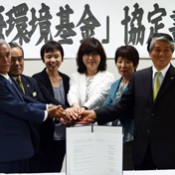
April 11, 2014 Tetsuya Nakajima correspondent of Ryukyu Shimpo
An agreement signing ceremony for a fund to protect Mozuku seaweed was held on April 2 at the town office on Kumejima Island. Kumejima Mayor Choko Taira, Seiji Tonaki, the president of the Kumejima Fishing Cooperative, Takayuki Kimura, the president of the seafood company, Takayo Muto, the executive director of Wakayama Citizens Co-op and Yoko Matsumoto, the vice president of Osaka Izumi Citizens Co-op took part in the ceremony.
Three yen from each sale of products from Kumejima stores will go to the fund, which will be donated to the municipal office. The donations will be used for activities such as clearing rubbish that drifts ashore and planting vetiver grass to prevent red soil from flowing into the sea. Kimura, the president of the seafood company, said, “We would like to sell good quality mozuku to our customers by cooperating with the farmers.” Tonaki, the president of the fishing cooperative, said, “We are striving to farm the seaweed responsibly.” Taisuku Endo, the group leader who is responsible for natural mozuku at the cooperative, promised stable supply of the product.
(English translation by T&CT)
Go to Japanese

April 14, 2014 Ryukyu Shimpo
In Gusukube district of Miyakojima City on April 8, people carried out a traditional Ryukyuan ritual Nerpai to pray for a good harvest and set up charms against tsunami.
About 30 citizens of two villages, Sunagawa and Tomori, took part in the ritual.
Local women prayed for calm in society and set up bamboo sticks known as datifu or danchiku at earmarked spots as charms to keep tsunami away.
In the morning, the local people gathered at Wipyayama in Sunagawa, where women sang a Ryukyuan divine song called Niri and prayed in the sacred room. The women then walked in a line and set up datifu sticks at the spots, praying that their homes will be safe from tsunami
After the women left, the men remained at Wipyayama to carry out the ritual in which they sang a sacred song and performed a dance mimicking the motions of rowing a boat.
A 67-year-old Tomoyoshi Uezato who is a member of the Sunagawa Neighborhood Community Association and leader of the ritual, said, “I used to go with my parents and watch how the people carry out the ritual. I am concerned that fewer and fewer people are taking part. I would like to tell people about the importance of taking over the ritual.”
(English translation by T&CT)
Go to Japanese









 Webcam(Kokusai Street)
Webcam(Kokusai Street)


